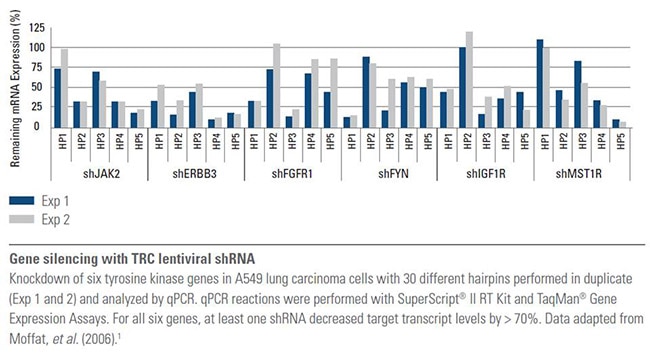TRC Lentiviral shRNA
Simple hairpin shRNAs in the pLKO.1 lentiviral vector designed by The RNAi Consortium (TRC)

TRC Lentiviral shRNA
1Start Here
2Choose
The RNAi consortium (TRC) is a collaborative effort based at the Broad Institute of MIT and Harvard, and includes six MIT and Harvard associated research institutions and five international life sciences organizations. We partnered with the TRC to make the shRNA libraries available to researchers worldwide. The libraries, targeting human and mouse annotated genes, contain shRNA constructs designed to include a hairpin of 21 base pair sense and antisense stem, and a 6 basepair loop.
Each hairpin sequence was cloned into the lentiviral vector (pLKO.1) and sequence verified. Multiple constructs (4 to 5) were created per gene to ensure adequate coverage of the target gene.
The pLKO1 lentiviral vector enables efficient transduction of primary and non-dividing cells, such as neuronal cells making it easy to perform RNAi studies in these hard to transfect cell lines. Stable selection is also possible using the puromycin selectable marker. The pLKO.1 reagents can be packaged into virus particles for use in transduction experiments. Specifically, the replication-incompetent viral particles can be efficiently produced using lentiviral packaging plasmids co-transfected in 293T packaging cells. The Trans-Lentiviral packaging system which offers maximum biosafety and high titers is recommended.
Highlights
- Rules-based shRNA design for efficient gene knockdown
- Already cloned into lentiviral vectors
- Amenable to in vitro and in vivo applications, such as the creation of stable knockdowns
- Lentiviral vector enables transduction of primary and non-dividing cell lines
- Broad coverage: 4 to 5 constructs per gene
- Further information is available at http://www.broad.mit.edu/genome_bio/trc/rnai.html
Citing the library in Scientific Publications
In scientific publications, the libraries should be referred to as TRC-Hs1.0 (Human) and TRC-Mm1.0 (Mouse). Individual clones are uniquely identified by their TRC ID number (eg. TRCN0000014783).
shRNA Controls
TRC Lentiviral shRNA Controls
- Inducible shRNA positive and non-targeting negative controls are available as glycerol stock or viral particles.
TRC pLKO.1 lentiviral vector
Gene silencing with TRC lentiviral shRNA

- J. Moffat et al., A Lentiviral RNAi Library for Human and Mouse Genes Applied to an Arrayed Viral High-Content Screen. Cell.124, 1283-1298 (2006).
- S. A. Stewart et al., Lentivirus-delivered stable gene silencing by RNAi in primary cells. RNA. 9, 493-501 (2003).
- R. Zufferey et al., Multiply attenuated lentiviral vector achieves efficient gene delivery in vivo. Nat. Biotechnol.15, 871-885 (1997).
- R. Zufferey et al., Self-inactivating lentivirus vector for safe and efficient in vivo gene delivery. J Virol. 72, 9873-9880 (1998).
- T. Yamamoto, Y. Tsunetsugu-Yokota. Prospects for the therapeutic application of lentivirus-based gene therapy to HIV-1 infection. Curr. Gene Ther.8(1), 1-8 (2008).
Protocols
Safety data sheets
Selection guides
Technical manuals
Related Products
Positive and negative pLKO.1 shRNA controls are a critical part of a well-designed gene silencing experiment. Available TRC shRNA controls include the pLKO.1 empty vector as a negative control and an eGFP shRNA as a positive control.
The RNAi Consortium, or TRC, is a public-private effort based at the Broad whose mission is to create a shRNA library to enable the scientific community to use RNAi to determine the function of human and mouse genes.
